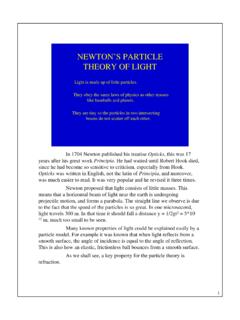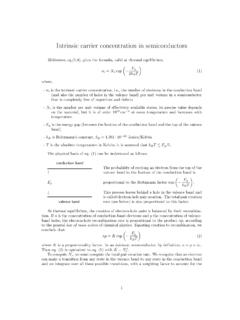Transcription of Lectures on Heat and Thermodynamics
1 Lectures on Heat and Thermodynamics Physics 152. Michael Fowler, University of Virginia 8/30/08. Contents Feeling and seeing temperature 3. Classic Dramatic Uses of Temperature-Dependent 4. The First Thermometer .. 5. Newton's Anonymous Table of Temperatures .. 7. Fahrenheit's Excellent Thermometer .. 7. Amontons' Air Thermometer: Pressure Increases Linearly with Temperature .. 7. Thermal Equilibrium and the Zeroth Law of 8. Measuring Heat Flow: a Unit of Heat .. 8. Specific Heats and Calorimetry .. 9. A Connection With Atomic Theory .. 10. Latent Heat .. 11. THERMAL EXPANSION AND THE GAS Coefficients of 12. Gas Pressure Increase with 13. Finding a Natural Temperature 13. The Gas Law .. 14. Avogadro's 15. EARLY ATTEMPTS TO UNDERSTAND THE NATURE OF HEAT ..16. When Heat Flows, What, Exactly is Flowing?
2 16. Lavoisier's Caloric Fluid Theory .. 16. The Industrial Revolution and the Water Wheel .. 17. Measuring Power by Lifting .. 18. Carnot's Caloric Water Wheel .. 18. How Efficient are these Machines? .. 19. Count Rumford .. 20. Rumford's Theory of 22. THE DISCOVERY OF ENERGY CONSERVATION: MAYER AND JOULE ..24. Robert Mayer and the Color of 24. James Joule .. 26. But Who Was First: Mayer or Joule? .. 27. The Emergence of Energy Conservation .. 27. KINETIC THEORY OF GASES: A BRIEF 2. Bernoulli's Picture .. 28. The Link between Molecular Energy and Pressure .. 29. Maxwell finds the Velocity Distribution .. 30. Velocity Space .. 31. Maxwell's Symmetry Argument .. 32. What about Potential Energy? .. 37. Degrees of Freedom and Equipartition of Energy .. 39. Brownian Motion .. 39. IDEAL GAS Thermodynamics : SPECIFIC HEATS, ISOTHERMS, ADIABATS.
3 39. Introduction: the Ideal Gas Model, Heat, Work and Thermodynamics .. 39. The Gas Specific Heats CV and CP .. 40. Tracking a Gas in the (P, V) Plane: Isotherms and Adiabats .. 42. Equation for an Adiabat .. 44. HEAT ENGINES: THE CARNOT CYCLE ..46. The Ultimate in Fuel Efficiency .. 46. Step 1: Isothermal Expansion .. 47. Step 2: Adiabatic 48. Steps 3 and 4: Completing the Cycle .. 49. Efficiency of the Carnot Engine .. 51. THE LAWS OF Thermodynamics AND LIMITS ON ENGINE EFFICIENCY ..53. The Laws of 53. How the Second Law Limits Engine Efficiency .. 55. A NEW THERMODYNAMIC VARIABLE: ENTROPY ..57. Introduction .. 57. Heat Changes along Different Paths from a to c are Different! .. 57. But Something Heat Related is the Same: Introducing 59. Finding the Entropy Difference for an Ideal 61. Entropy in Irreversible Change: Heat Flow Without 62.
4 Entropy Change without Heat Flow: Opening a Divided 62. The Third Law of Thermodynamics .. 64. ENTROPY AND THE KINETIC THEORY: THE MOLECULAR PICTURE ..64. Searching for a Molecular Description of Entropy .. 64. Enter the Demon .. 65. Boltzmann Makes the 66. Epitaph: S = k ln W .. 68. But What Are the Units for Measuring W ? .. 68. A More Dynamic Picture .. 68. The Removed Partition: What Are the Chances of the Gas Going Back?.. 69. Demon 70. Entropy and Disorder .. 71. Summary: Entropy, Irreversibility and the Meaning of 71. Everyday Examples of Irreversible Processes .. 72. MOLECULAR COLLISIONS ..73. Difficulties Getting the Kinetic Theory 73. How Fast Are Smelly Molecules? .. 73. The Mean Free 74. 3. Gas Viscosity Doesn't Depend on Density!.. 74. Gas Diffusion: the Pinball Scenario; Finding the Mean Free Path in Terms of the Molecular Diameter.
5 74. But the Pinball Picture is Too Simple: the Target Molecules Are Moving! .. 78. If Gases Intermingle in One Second, How Far in One Hour? .. 78. Actually Measuring Mean Free 79. Why did Newton get the Speed of Sound Wrong? .. 80. BROWNIAN Introduction: Jiggling Pollen 80. Einstein's Theory: the Osmosis Analogy .. 81. An Atmosphere of Yellow 83. Langevin's Theory .. 84. References .. 86. HEAT TRANSPORT: CONDUCTION, CONVECTION, RADIATION ..87. 87. Microscopic Picture of 87. American 88. Convection .. 88. 89. Heat Feeling and seeing temperature changes Within some reasonable temperature range, we can get a rough idea how warm something is by touching it. But this can be unreliable if you put one hand in cold water, one in hot, then plunge both of them into lukewarm water, one hand will tell you it's hot, the other will feel cold.
6 For something too hot to touch, we can often get an impression of how hot it is by approaching and sensing the radiant heat. If the temperature increases enough, it begins to glow and we can see it's hot! The problem with these subjective perceptions of heat is that they may not be the same for everybody. If our two hands can't agree on whether water is warm or cold, how likely is it that a group of people can set a uniform standard? We need to construct a device of some kind that responds to temperature in a simple, measurable way we need a thermometer. The first step on the road to a thermometer was taken by one Philo of Byzantium, an engineer, in the second century BC. He took a hollow lead sphere connected with a tight seal to one end of a pipe, the other end of the pipe being under water in another vessel.
7 4. To quote Philo: if you expose the sphere to the sun, part of the air enclosed in the tube will pass out when the sphere becomes hot. This will be evident because the air will descend from the tube into the water, agitating it and producing a succession of bubbles. Now if the sphere is put back in the shade, that is, where the sun's rays do not reach it, the water will rise and pass through the tube . No matter how many times you repeat the operation, the same thing will happen. In fact, if you heat the sphere with fire, or even if you pour hot water over it, the result will be the same.. Notice that Philo did what a real investigative scientist should do he checked that the experiment was reproducible, and he established that the air's expansion was in response to heat being applied to the sphere, and was independent of the source of the heat.
8 Classic Dramatic Uses of Temperature-Dependent Effects This expansion of air on heating became widely known in classical times, and was used in various dramatic devices. For example, Hero of Alexandria describes a small temple where a fire on the altar causes the doors to open. 5. The altar is a large airtight box, with a pipe leading from it to another enclosed container filled with water. When the fire is set on top of the altar, the air in the box heats up and expands into a second container which is filled with water. This water is forced out through an overflow pipe into a bucket hung on a rope attached to the door hinges in such a way that as the bucket fills with water, it drops, turns the hinges, and opens the doors. The pipe into this bucket reaches almost to the bottom, so that when the altar fire goes out, the water is sucked back and the doors close again.
9 (Presumably, once the fire is burning, the god behind the doors is ready to do business and the doors open ). Still, none of these ingenious devices is a thermometer. There was no attempt (at least none recorded) by Philo or his followers to make a quantitative measurement of how hot or cold the sphere was. And the meter in thermometer means measurement. The First Thermometer Galileo claimed to have invented the first thermometer. Well, actually, he called it a thermoscope, but he did try to measure degrees of heat and cold according to a colleague, and that qualifies it as a thermometer. (Technically, a thermoscope is a device making it possible to see a temperature change, a thermometer can measure the temperature change.) Galileo used an inverted narrow- necked bulb with a tubular neck, like a hen's egg with a long glass tube attached at the tip.
10 6. He first heated the bulb with his hands then immediately put it into water. He recorded that the water rose in the bulb the height of one palm . Later, either Galileo or his colleague Santorio Santorio put a paper scale next to the tube to read off changes in the water level. This definitely made it a thermometer, but who thought of it first isn't clear (they argued about it). And, in fact, this thermometer had problems. Question: what problems? If you occasionally top up the water, why shouldn't this thermometer be good for recording daily changes in temperature? Answer: because it's also a barometer! But Galileo didn't know about the atmospheric pressure. Torricelli, one of Galileo's pupils, was the first to realize, shortly after Galileo died, that the real driving force in suction was external atmospheric pressure, a satisfying mechanical explanation in contrast to the philosophical nature abhors a vacuum.




